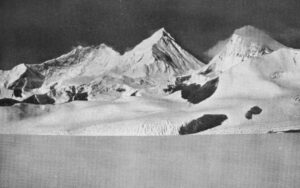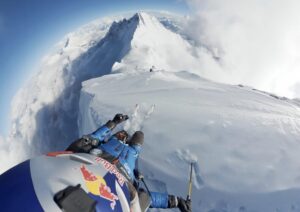Good weather held through the weekend, permitting a large number of summits. Among them, German David Goettler finally summited Everest on Saturday without supplementary oxygen or personal Sherpa support.
Kristin Harila took a mind-blowing 9h 5min to summit both Everest and Lhotse, via Camp 4 on the South Col.
Adriana Brownlee, climbing with Gelje Sherpa, also ticked off Lhotse on Saturday, as the latest in her multi-peak season. Both Harila and Brownlee fly to Makalu tomorrow morning, weather permitting.

So far, so good: Kristin Harila. Photo: Kristin Harila
Weather changing
After a remarkably long weather window in the Everest region, the wind is quickly picking up and snow is already falling. Those who waited too long to launch their summit pushes may face tougher conditions or have no chance at all. It will depend on how these new weather systems evolve.
This includes James McMannus of Ireland, who is also planning on a no-O2 climb. Currently, he is in Camp 2. He had hoped to summit on May 24, but forecasts nopw show high winds from May 24 to 28, Paul Devaney told ExplorersWeb.
McMannus’s only chance will be if the forecast is wrong. The Sagarmatha Pollution Control Committee announced on Sunday that the Khumbu Icefall will close by May 29 at 11 am at the latest. All teams must be back in Base Camp by then.
The Everest-Lhotse double-header
Climbing Lhotse immediately after Everest has become a common option for fit climbers with plenty of oxygen if the weather remains good. After Everest, the climbers return to Camp 4 on the South Col to rehydrate, eat, and rest a little. They then set off again the following night toward the summit of Lhotse. Topping out on Lhotse the following morning, they then return to Camp 4. Those tireless enough go all the way down to Camp 2. This weekend, Kristin Harila did even better, reaching both summits on the same day, then returning all the way to Base Camp!
Nirmal Purja, leading an Elite Exped team, climbed the two mountains in a neat 26 hours — without supplementary O2!
This means that he used no bottled gas from leaving Base Camp on May 10 until he and his team reached the summit of Everest on May 15. He would then have continued without a mask down to C4 and during the night until 3 am on May 16. At this time, the group set off toward Lhotse. Still no-O2. Finally, he descended all the way down to Base Camp the same way.
That is an extremely long time under severe oxygen deprivation. What Nims did is rarely attempted and even more rarely achieved.
Anatoly Boukreev
The first climber to complete that double climb and make it down alive was Kazakhstan’s legendary Anatoli Boukreev. (Josef Just of Czechoslovakia did it eight years earlier but he died during the descent.)
Boukreev always refused to use canned O2, which he deeply distrusted, even when he guided on Everest during the 1996 Into Thin Air disaster. He was later heavily criticized for his decision to forego bottled oxygen.

May 16: IFMGA guide Tenji Sherpa and Nirmal Purja on the summit of Lhotse, with Everest in the background. Photo: Nirmal Purja/Instagram
Nirmal Purja‘s team last week consisted of some of the strongest Sherpas in Nepal, which means some of the strongest Himalayan climbers in the world. These include Lakpa Dendi, Mingma Tenzi (K2 winter summiter, with 28 8,000m summits to his credit), plus Tenji Sherpa, Ueli Steck’s former partner and an accredited IFMGA guide.
Peaks enchained, not traversed
When speaking about a 14×8,000m project, some purists might object to counting Lhotse as a complete climb if done right after Everest, since climbers ascend Lhotse from the two peaks’ shared Camp 4, at 8,000m. Meanwhile, climbers going only for Lhotse climb all the way from Base Camp, as Brownlee and Gelje Sherpa did. However, The Himalayan Database accepts both summits equally.
But the Everest-Lhotse double-header must be properly tagged: Some media describe it as an “Everest-Lhotse traverse”.
We should not mistake this with the pure Everest-Lhotse traverse. This follows the ridge from the summit of Everest to the col, then across all points of Lhotse until the main summit. Completing this traverse has been the dream of some of the best climbers in history, including Tenji Sherpa. Tenji was going to attempt the traverse with Ueli Steck when Steck died while acclimatizing on Nuptse in 2017.
Editor’s note: Even this explanation of the traverse is not complete. We are currently working on a separate article to clarify what mountaineers mean by a traverse, especially in the context of Everest and Lhotse.






